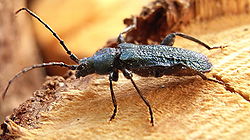Blue-colored target bracket
| Blue-colored target bracket | ||||||||||||
|---|---|---|---|---|---|---|---|---|---|---|---|---|

Blue-colored target stand on spruce |
||||||||||||
| Systematics | ||||||||||||
|
||||||||||||
| Scientific name | ||||||||||||
| Callidium aeneum | ||||||||||||
| ( De Geer , 1775) |
Callidium aeneum is a beetle from the family of longhorn beetles .
The species is listed in the red lists of various federal states. In Thuringia and Saxony-Anhalt it is classified as "endangered", in Schleswig-Holstein , North Rhine-Westphalia and Brandenburg as "highly endangered". In Rhineland-Palatinate and Mecklenburg-Western Pomerania , the species is regarded as a "rare species without current threat" or "not endangered".
Notes on the name
The beetle has several German names. The name blue-colored disc goat is misleading, because the closely related blue-violet disc goat , also called "violet goat" or just "blue disc goat" for short, is much more blue than Callidium aeneum . Callidium aeneum is sometimes even apostrophized as the green billy goat, in contrast to the blue-winged disc buck. The German name Erzfarbener Scheibenbock corresponds most closely to the Latin name . In addition, the German name Platter Fichten-Scheibenbock or just Fichten-Scheibenbock is common. The latter is, however, misleading in that other disc bucks also breed in spruce trees.
The species was first described by De Geer in 1775 and classified as No. 25 in the genus Cerambyx . The description begins with the words d'un vert foncé, bronzé luisant ( French for dark green, shiny ore-colored). Accordingly, de Geer gives the species the French name Capricorne bronzé and the Latin name Cerambyx aeneus (ore-colored longhorn beetle). The genus Callidium (from ancient Greek κάλλος kállos, beauty and ίδιος ídios, own) was established in the same year by Fabricius based on the construction of the mouthparts as a new genus. In German, the name is usually given with a disk buck. The genus comprises three species in Europe and over thirty species worldwide, some of which are grouped into subgenera.
Description of the beetle
The flat beetle reaches a length between nine and fifteen millimeters. It is colored metallic green to bronze. Since its eleven-jointed antennae do not reach the full length of the body in the male and are shorter in the female, it is not immediately recognizable as a longhorn beetle. The short second antennae in connection with the cone-shaped front hips protruding from the front chest and the kidney-shaped eyes place the beetle within the longhorn beetles in the subfamily of the Cerambycinae . It has the flat and rounded pronotum in common with the group of disc bucks. The pronotum of the genus Callidium is wider than it is long. The legs are short stalked at the base, then strongly thickened to form a club. The coarsely reticulated corrugated wing-covers distinguish it from the other species of the genus.
biology
The species is a forest inhabitant, it is particularly found in spruce and pine forests. The adults usually sit on dead wood, felled trunks, cordwood, brushwood and firewood, preferably on spruce , less often on pine and larch . Occasionally they can also be found on hardwood and blooming hawthorn .
The development of the beetle is annual in fresh wood and perennial in built-up wood. The larva only eats under the bark, but the pupa cradle is laid as a hook-shaped passage inwards into the wood. Therefore, the species can be harmful to weaker hardwood and softwood. However, the species is not common. The blue-colored disc buck is counted among the damp wood insects. The wood moisture must exceed 30% to allow development.
Occurrence
The species is widespread from montane to subalpine in wooded mountains. It occurs in almost all of Europe and Asia. In the plain it occurs only very rarely in old coniferous forests. In Central Europe, the adults are found in May to July.
supporting documents
Individual evidence
- ^ A b Distribution and systematics in Fauna Europaea
- ↑ Lists at Science4you
- ↑ C. De Geer: Memoires pour servir à l'histoire des insectes. Tome cinquième Stockholm 1775 first description of the species p.89.
- ↑ Sigmund Schenkling: Explanation of the scientific beetle names (genus)
- ↑ Io. Christ. Fabricius: Systema Entomologiae Flensburg, Leipzig 1775 First description of the genus p. 223: 187 50.
- ↑ Callidium in Fauna Europaea. Retrieved February 19, 2013
- ↑ Callidium at BioLib, plus links to subgenera
- ↑ a b www.holzschaedling.com ( page no longer available , search in web archives ) Info: The link was automatically marked as defective. Please check the link according to the instructions and then remove this notice.
- ↑ Classification as a damp wood insect
literature
- Heinz joy, Karl Wilhelm Harde, Gustav Adolf Lohse (ed.): The beetles of Central Europe . tape 9 . Cerambycidae Chrysomelidae . Spektrum Akademischer Verlag, Munich 1999, ISBN 3-8274-0683-8 (first edition: Goecke & Evers, Krefeld 1966).
- Klaus Koch : The Beetles of Central Europe . Ed .: Heinz Freude . tape 3 : ecology . Goecke & Evers, Krefeld 1992, ISBN 3-87263-042-3 .
- Adolf Horion : Beetle science for nature lovers . Vittorio Klostermann, Frankfurt am Main 1949

